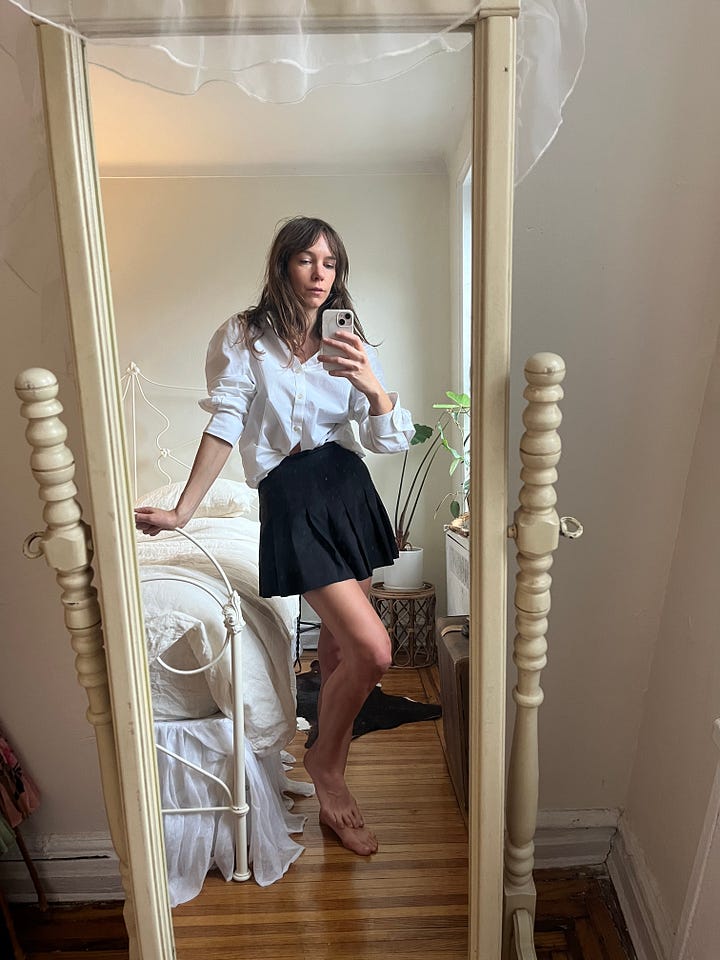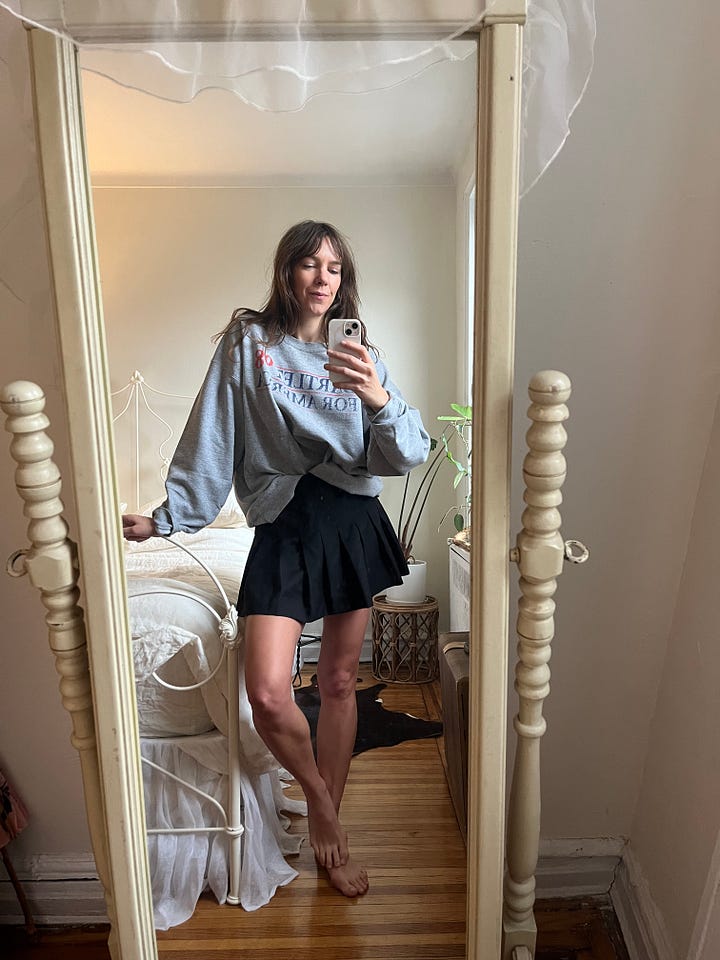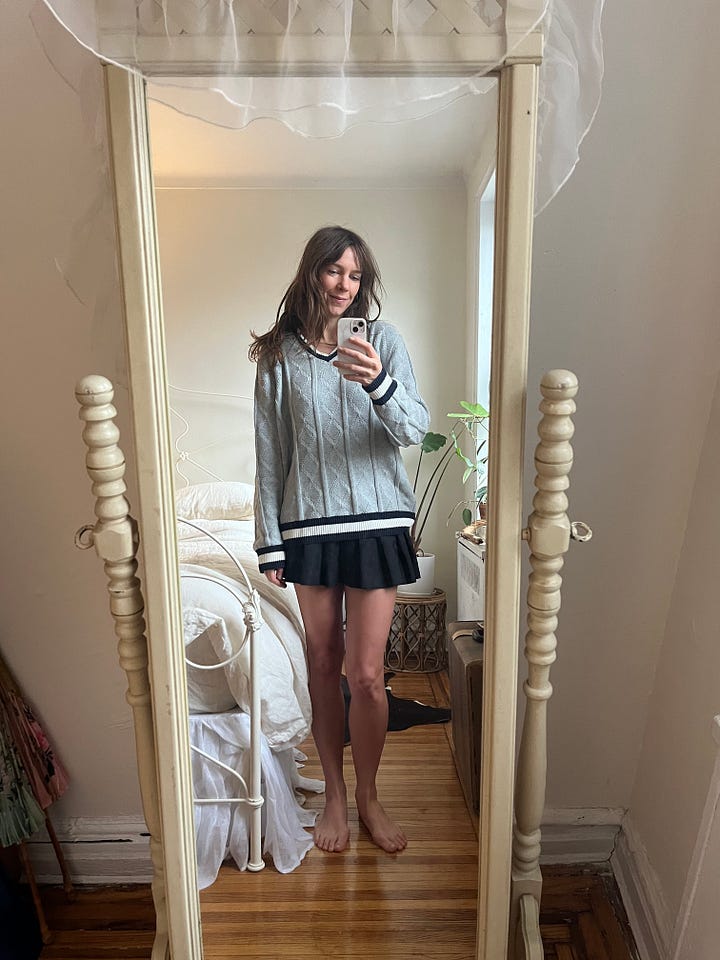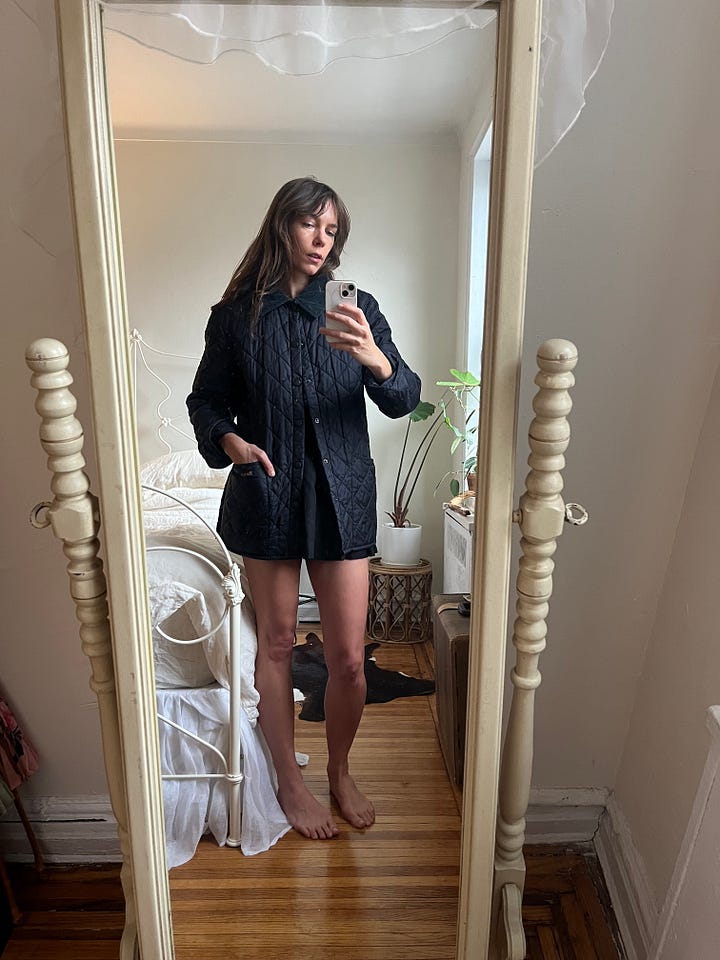The Art Of The Hand-Me-Down
Considering my most-worn pieces, clothing donations, and Kantamanto
Going through my closet at the end of December, I realized that the majority of my “new” clothes from 2024 were hand-me-downs. This was not entirely surprising. I knew that my most-worn pieces were given to me by friends last year, although the quantity was something to consider. For reasons I can’t pinpoint exactly, people give me their used clothes. Not in a “here’s a bag a stuff,” kind-of-way, a “I have a specific thing that I saved because I thought you might like it” way.
These hand-me-downs started a few years ago. My friend Michaela gave me a pair of her jeans for my 30th birthday. I was initially surprised—why was she giving me her old stuff?—then I saw them for the gift that they were: a pair of perfectly faded high-waisted vintage Levi’s jeans. They were pants she’d found and thought to pass onto me. I had them tailored to my body, wearing them so much they eventually split under my right cheek, the spot where my jeans always tear, and then later opening at the knees so now when I walk there are three gaping mouths.
Michaela has given me other pieces too, things she lovingly placed on her banister for me to look at when I came over. “Would you wear this?” she asks. “I thought you might like it.” I almost always do. Sometimes I look down and realize I’m wearing almost all Michaela hand-me-downs.
The pieces I seek have started coming to me too. Last February I wrote that I wanted “crisp white & blue button-ups;” two months later my friend Akhurapa brought me a bag of freshly ironed Charles Tyrwhitt shirts in whites, blues, purples, and pinks, plus this gray sweatshirt I wear all the damn time, a cable knit Brooks Brothers sweater, and a Barbour jacket that’s become one of my favorite layering pieces.




These hand-me-downs are often my most complimented too: the tan leather pants my colleague Jojo brought me this summer, the Kallmeyer trousers
gave me after styling her for The Clothes In Your Closet. They’re pieces I wouldn't have picked out for myself, but their owner’s belief that I could make them work inspired me to see where my imagination would take me, for that’s what styling is—playing dress up—resulting in my favorite outfit last year.
There’s a considered gift-giving element to these used clothes. Just as if the giver has gone out and bought them specifically for me. I’ve thought about the difference between this and donating as I’ve watched the trash bags of used clothes for LA wildfire relief pile up on Instagram: well-intentioned people dropping off discarded garments, leaving volunteers to sort through their stuff. I’m sure some of the clothes are of good quality, but the quantity, the bags and bags of, makes me pause.
The scene unfolding is a microcosm of the mountains of clothes that exist in Kantamanto, one of the world’s largest secondhand markets in Accra, Ghana, which caught fire on January 1st, just days before the LA fires. This market is where many of our clothes go to die, because even though the people and businesses who make up the market recirculate an astounding 25 million items every month—compared to ThredUp’s 200 million total and The RealReal’s 39.2 million total— there’s just too much stuff. According to the Or Foundation, an estimated 40% of the 15 million items that enter the market each week leave as waste. Of that waste, approximately 59-75% is hauled off by the city. The rest is burned or dumped and the plastic that makes up our predominantly polyester clothing leeches into Accra’s land, air, and water. The Global North’s fashion addiction becoming their problem.
Now volunteers in LA are also being confronted with our dirty laundry. Two days after the fires started, Johanna, the founder of clothing rental company OpenClosit, turned her Santa Monica store into a distribution center, providing clothing and supplies for neighbors in need. The work they’ve been doing is the epitome of community coming together to help each other. Their volunteers have processed bags and bags of clothing. Since then, their initial calls for physical donations have been replaced with gentle a reminder of how to mindfully donate used clothes. “Consider whether you yourself would want to wear or sleep in these items,” Jo shared on Instagram. It’s a question we should all ask when donating.
Over the past few weeks I’ve read newsletters about how to clean out your closet.
and give great advice, but the part that always feels skimmed over is what to do with the garments you no longer wear. I get this, because it’s the step I grapple with the most. There’s no large scale solution because fashion brands aren’t designing with circularity in mind; their goal is profit. If they were held financially accountable for their clothing waste, they’d be incentivized to innovate, but until then, the weight primarily lies on the individual.I find this infuriating, but then I remind myself that there are solutions I can piece together. Doing something is better than nothing at all.
I sell and donate my clothes locally because there’s a higher likelihood they won’t become someone else’s problem. INA and Tokio 7 are my preferred consignment shops. I like talking to the person who’s selling my stuff, and I think I get more money than if I were to consign with The RealReal. I also like to gift hand-me-downs; I gave my friend
a red faux-fur stole that I used to wear all the time for her recent birthday. I thought it’d look fabulous on her. It does. What a delight, seeing something I loved on someone I love. Lastly, on a nice sunny day I hang any remaining items on the fence outside my apartment building. I organize the pieces like they were in a store. Usually everything is gone in a few hours. I attribute this to how I merchandise my clothes; would you rather browse something that’s neatly displayed or crumpled in a box?Something I shared with
for her Stoop Series last week is to ask yourself why you want to shop your closet. Knowing your why is essential for whatever habit you want to develop; it gives you something to come back to when you want to give up. When I don’t wear something that I buy, like the blue sheer dress, I challenge myself to understand the reason so I’m less likely to repeat the purchase. It’s a learning process, one that I’ve been working on for the past five years. My rewards being peace of mind—and a damn good closet of clothes.As the realties of climate change continue to show up in our backyards, I’m resolved to expand my efforts beyond what I do or don’t buy. Individual choices matter—we all have the power to inspire those around us—but I also want to hold corporations accountable for knowingly profiting off of unsustainable business practices. My hope is that from these devastations, more and more people will be called to figure out what they can specifically do to help their community. The eternal optimist in me believes we will.
Donate to OpenClosit’s LA Wildfire Relief Efforts
Donate to the Or Foundation’s Kantamanto Fire Relief Funding
Get involved with the fight for human rights and climate justice in the fashion industry




Loved this thank you
Michaela, goddess gifter of entire wardrobes! 🙇♀️ (FYI everyone is allowed to hand me (up!) their flamboyant accessories any time 😎)